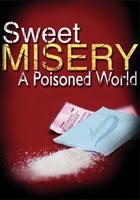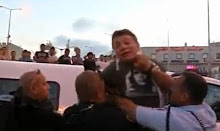IPS
Emilio Godoy
Kanya D'Almeida
MEXICO CITY/WASHINGTON, Aug 9, 2011 (IPS) - Late last week, the son of a top dog in Mexico's notorious Sinaloa drug cartel filed pleadings in a Chicago federal court accusing the U.S. government and its agencies of giving the cartel "carte blanche to continue to smuggle tons of illicit drugs into Chicago and the rest of the United States".
The charges, though virtually ignored by the U.S. media, have opened a window on U.S. drug policy south of its border, which many analysts have decried as corrupt and ineffective for years.
In his two-page court pleading, Jesus Vicente Zambada-Niebla – the son of Ismael "El Mayo" Zambada Garcia, an alleged leader of the Mexico- based Sinaloa drug- and weapons-trafficking organisation - described a collaborative relationship between the cartel and the U.S. Department of Justice and its many arms, including agencies such as the Drug Enforcement Administration (DEA) and the Federal Bureau of Investigation.
In late 2009, Zambada-Niebla was arrested in Mexico City and extradited to the U.S. to stand trial on charges of being the "logistical coordinator" for the cartel, specifically for overseeing an operation that shipped "multi-ton quantities of cocaine" into the U.S. using various transport methods from Boeing 747 cargo aircraft to tractor-trailers.
According to Bill Conroy, a journalist who broke this story and several others for Narco News a full week ahead of other media outlets, Zambada-Niebla also claims to have been an asset for the U.S. government, including being a party to deals struck between DEA agents and hard-hitters of the Sinaloa organisation. These allegedly included promises of protection by the DEA in exchange for information about rival cartels.
Zambada-Niebla's pleadings claim that protection included promises to the cartel leadership to be kept apprised of U.S. and Mexican government investigations occurring close to the "home territories of [Sinaloa's leaders] so that [they] could take appropriate actions to evade investigators," even though the U.S. government had indictments, extradition requests, and rewards for the apprehension of certain members of Sinaloa's leadership.
The pleadings indicate that U.S. officials acted on the assumption that keeping Mexican authorities in the dark about backroom security deals with one of the most powerful cartels in the country was a worthy exchange for information extracted from informants like Zambada Niebla.
Meanwhile, some 40,000 Mexican civilians have perished in the U.S.- sponsored crackdown on the drug trade.
In early May, Conroy crunched the numbers from the U.S. State Department's most recent data on military spending for Fiscal Years 2008-2009 and found that, in addition to 177 million dollars worth of defence hardware funnelled to companies in Mexico via private corporations in the U.S., 204 million dollars in arms were also sent across the border.
A history of corruption
This isn't the first time that U.S. agencies have been enmeshed in drug trafficking activities. Official documents and testimonies from the Iran-contra scandal proved that such activities date back at least to the 1980s.
In 1990, then-DEA agents Wayne Schmidt and Hector Berrelez wrote a secret report that referenced the assassination of Mexican journalist Manuel Buendia in 1984.
A well-known columnist, Buendia possessed information about what was believed to be training camp of "Guatemalan guerrillas" in the southeastern state of Veracruz, which in fact turned out to be a breeding ground for mercenaries of the Nicaraguan Contra.
Between 1981 and 1986, during the first five of its eight years in office, Ronald Reagan's Republican administration waged a clandestine war against the Nicaraguan Sandinista regime, led by Daniel Ortega. That campaign was made possible by the financing and training of the Contras, a guerrilla group that was fuelled by profits from the narco- trade.
"In exchange for getting money for the Contra, the Central Intelligence Agency [CIA] created a relationship with the Medellin Cartel and with mid-sized Mexican drug dealers. Thanks to that connection, the Mexicans grew… from being [small-time] sellers, they entered the big cocaine market," Anabel Hernandez, Mexican journalist and author of the recent explosive best-seller 'Los Señores del Narco' (The Drug Lords), told IPS.
In 1977, Miguel Caro, Ernesto Fonseca and Miguel Felix Gallardo, leaders of the Guadalajara Cartel – the seed of the Sinaloa Cartel – were introduced to the Honduran Ramon Mata Ballesteros, the human link with the Colombian drug traffickers.
Together, they began to transport the powder from South America to the U.S., an activity that earned them millions of dollars.
Several years later, Mexican kingpins entered the 'Irangate' equation.
The Guadalajara Cartel distributed the Colombian cocaine. The money was used to buy arms and military equipment from Iran and to free U.S. hostages in Iran and Lebanon, and the weapons ended up in the hands of the Contras. Pablo Escobar, the deceased head of the Medellin Cartel, gave 10 million dollars to the Nicaraguan mercenaries.
The Kerry Committee report, the final document detailing the hearings sponsored by Democrat Senator John Kerry, concluded in 1989 that the "narcos" gave airplanes, arms, money and logistics support to the Contras.
In a trial in Los Angeles in 1988, the U.S. pilot Theodore Cash acknowledged that he himself flew planes for the CIA during a 10-year period, flights that may have included weapons drops to the Contras.
Caro and Fonseca have been in prison since 1985 for the assassination of DEA agent Enrique "Kiky" Camarena, whereas Felix was arrested in 1989. Meanwhile, Mata has languished in a U.S. prison since that same year.
If Irangate happened with impunity, "Why wouldn't it happen again 10 or 20 times? That school remains forever," said Hernandez, whose book cites an anonymous source confirming Mexico's role as a storehouse and channel for arms and drugs.
"Now, the U.S. government will have to respond to Zambada-Niebla's allegations," she added.
Conroy told IPS, "Some of my CIA sources indicate that if you look back at the [Iran-Contra] era, everyone who was charged got off scot- free, there were absolutely no consequences - which proves, as far as intelligence is concerned, that this method works. In fact, it is a self-funding operation."
"The only difference was that the Iran-Contra affair was political, whereas the Mexican drug wars and the U.S. involvement is becoming, increasingly, solely about monetary and economic [motives]," he said.
The Guadalajara Cartel was the forerunner of the Sinaloa Cartel, led by Joaquin "El Chapo" Guzman, the most powerful drug lord in history, according to the DEA.
Following the assassination of Osama Bin Laden in May, Guzman, who escaped from a high-security prison in 2001, rocketed to the top of the FBI's "Most Wanted" persons list and even made it onto Forbes Magazine's 2010 list of "The World's Most Powerful People".
When he fled prison, "He was nobody in the criminal world. In a decade, he has been transformed into a legend" - something that wouldn't have occurred without the corruption in Mexico and the complicity of the U.S., Hernandez said.
*Emilio Godoy reported from Mexico City.
Emilio Godoy
Kanya D'Almeida
MEXICO CITY/WASHINGTON, Aug 9, 2011 (IPS) - Late last week, the son of a top dog in Mexico's notorious Sinaloa drug cartel filed pleadings in a Chicago federal court accusing the U.S. government and its agencies of giving the cartel "carte blanche to continue to smuggle tons of illicit drugs into Chicago and the rest of the United States".
The charges, though virtually ignored by the U.S. media, have opened a window on U.S. drug policy south of its border, which many analysts have decried as corrupt and ineffective for years.
In his two-page court pleading, Jesus Vicente Zambada-Niebla – the son of Ismael "El Mayo" Zambada Garcia, an alleged leader of the Mexico- based Sinaloa drug- and weapons-trafficking organisation - described a collaborative relationship between the cartel and the U.S. Department of Justice and its many arms, including agencies such as the Drug Enforcement Administration (DEA) and the Federal Bureau of Investigation.
In late 2009, Zambada-Niebla was arrested in Mexico City and extradited to the U.S. to stand trial on charges of being the "logistical coordinator" for the cartel, specifically for overseeing an operation that shipped "multi-ton quantities of cocaine" into the U.S. using various transport methods from Boeing 747 cargo aircraft to tractor-trailers.
According to Bill Conroy, a journalist who broke this story and several others for Narco News a full week ahead of other media outlets, Zambada-Niebla also claims to have been an asset for the U.S. government, including being a party to deals struck between DEA agents and hard-hitters of the Sinaloa organisation. These allegedly included promises of protection by the DEA in exchange for information about rival cartels.
Zambada-Niebla's pleadings claim that protection included promises to the cartel leadership to be kept apprised of U.S. and Mexican government investigations occurring close to the "home territories of [Sinaloa's leaders] so that [they] could take appropriate actions to evade investigators," even though the U.S. government had indictments, extradition requests, and rewards for the apprehension of certain members of Sinaloa's leadership.
The pleadings indicate that U.S. officials acted on the assumption that keeping Mexican authorities in the dark about backroom security deals with one of the most powerful cartels in the country was a worthy exchange for information extracted from informants like Zambada Niebla.
Meanwhile, some 40,000 Mexican civilians have perished in the U.S.- sponsored crackdown on the drug trade.
In early May, Conroy crunched the numbers from the U.S. State Department's most recent data on military spending for Fiscal Years 2008-2009 and found that, in addition to 177 million dollars worth of defence hardware funnelled to companies in Mexico via private corporations in the U.S., 204 million dollars in arms were also sent across the border.
A history of corruption
This isn't the first time that U.S. agencies have been enmeshed in drug trafficking activities. Official documents and testimonies from the Iran-contra scandal proved that such activities date back at least to the 1980s.
In 1990, then-DEA agents Wayne Schmidt and Hector Berrelez wrote a secret report that referenced the assassination of Mexican journalist Manuel Buendia in 1984.
A well-known columnist, Buendia possessed information about what was believed to be training camp of "Guatemalan guerrillas" in the southeastern state of Veracruz, which in fact turned out to be a breeding ground for mercenaries of the Nicaraguan Contra.
Between 1981 and 1986, during the first five of its eight years in office, Ronald Reagan's Republican administration waged a clandestine war against the Nicaraguan Sandinista regime, led by Daniel Ortega. That campaign was made possible by the financing and training of the Contras, a guerrilla group that was fuelled by profits from the narco- trade.
"In exchange for getting money for the Contra, the Central Intelligence Agency [CIA] created a relationship with the Medellin Cartel and with mid-sized Mexican drug dealers. Thanks to that connection, the Mexicans grew… from being [small-time] sellers, they entered the big cocaine market," Anabel Hernandez, Mexican journalist and author of the recent explosive best-seller 'Los Señores del Narco' (The Drug Lords), told IPS.
In 1977, Miguel Caro, Ernesto Fonseca and Miguel Felix Gallardo, leaders of the Guadalajara Cartel – the seed of the Sinaloa Cartel – were introduced to the Honduran Ramon Mata Ballesteros, the human link with the Colombian drug traffickers.
Together, they began to transport the powder from South America to the U.S., an activity that earned them millions of dollars.
Several years later, Mexican kingpins entered the 'Irangate' equation.
The Guadalajara Cartel distributed the Colombian cocaine. The money was used to buy arms and military equipment from Iran and to free U.S. hostages in Iran and Lebanon, and the weapons ended up in the hands of the Contras. Pablo Escobar, the deceased head of the Medellin Cartel, gave 10 million dollars to the Nicaraguan mercenaries.
The Kerry Committee report, the final document detailing the hearings sponsored by Democrat Senator John Kerry, concluded in 1989 that the "narcos" gave airplanes, arms, money and logistics support to the Contras.
In a trial in Los Angeles in 1988, the U.S. pilot Theodore Cash acknowledged that he himself flew planes for the CIA during a 10-year period, flights that may have included weapons drops to the Contras.
Caro and Fonseca have been in prison since 1985 for the assassination of DEA agent Enrique "Kiky" Camarena, whereas Felix was arrested in 1989. Meanwhile, Mata has languished in a U.S. prison since that same year.
If Irangate happened with impunity, "Why wouldn't it happen again 10 or 20 times? That school remains forever," said Hernandez, whose book cites an anonymous source confirming Mexico's role as a storehouse and channel for arms and drugs.
"Now, the U.S. government will have to respond to Zambada-Niebla's allegations," she added.
Conroy told IPS, "Some of my CIA sources indicate that if you look back at the [Iran-Contra] era, everyone who was charged got off scot- free, there were absolutely no consequences - which proves, as far as intelligence is concerned, that this method works. In fact, it is a self-funding operation."
"The only difference was that the Iran-Contra affair was political, whereas the Mexican drug wars and the U.S. involvement is becoming, increasingly, solely about monetary and economic [motives]," he said.
The Guadalajara Cartel was the forerunner of the Sinaloa Cartel, led by Joaquin "El Chapo" Guzman, the most powerful drug lord in history, according to the DEA.
Following the assassination of Osama Bin Laden in May, Guzman, who escaped from a high-security prison in 2001, rocketed to the top of the FBI's "Most Wanted" persons list and even made it onto Forbes Magazine's 2010 list of "The World's Most Powerful People".
When he fled prison, "He was nobody in the criminal world. In a decade, he has been transformed into a legend" - something that wouldn't have occurred without the corruption in Mexico and the complicity of the U.S., Hernandez said.
*Emilio Godoy reported from Mexico City.
Intelligence Operations Gone Wrong
Zambada-Niebla's trial drives home the reality of intelligence operations by referencing the controversial U.S Bureau of Alcohol, Tobacco, Firearms and Explosives (ATF) weapons-trafficking operation known as "Fast and Furious".
Currently the subject of congressional hearings, the operation was an attempt to track gun sales in the U.S. to cartels inside Mexico. Under the programme, run out of the ATF headquarters in Phoenix, Arizona, close to 2,500 firearms – including hundreds of AK-47s and Barrett .50 caliber rifles – were sold to "straw" buyers who handed them off to gunrunners in plain sight of the ATF.
Since the operation commenced in 2008, thousands of guns have disappeared across the border. The absence of a keen mechanism to track the weapons back to cartel leaders means that they are now safely in the hands of some of Mexico's most relentless criminals.
Laura Carlsen, director of the Mexico City-based Americas Programme of the Center for International Policy, reported that in late 2010, some of these "walked guns" were traced to the murder of U.S. Border Patrol Agent Brian Terry.
Furthermore, Zambada- Niebla's pleadings assert that, as a result of the botched operation, roughly "three thousand people" in Mexico were killed "including law enforcement officers in the sate of Sinaloa, Mexico, headquarters of the Sinaloa Cartel".
Currently the subject of congressional hearings, the operation was an attempt to track gun sales in the U.S. to cartels inside Mexico. Under the programme, run out of the ATF headquarters in Phoenix, Arizona, close to 2,500 firearms – including hundreds of AK-47s and Barrett .50 caliber rifles – were sold to "straw" buyers who handed them off to gunrunners in plain sight of the ATF.
Since the operation commenced in 2008, thousands of guns have disappeared across the border. The absence of a keen mechanism to track the weapons back to cartel leaders means that they are now safely in the hands of some of Mexico's most relentless criminals.
Laura Carlsen, director of the Mexico City-based Americas Programme of the Center for International Policy, reported that in late 2010, some of these "walked guns" were traced to the murder of U.S. Border Patrol Agent Brian Terry.
Furthermore, Zambada- Niebla's pleadings assert that, as a result of the botched operation, roughly "three thousand people" in Mexico were killed "including law enforcement officers in the sate of Sinaloa, Mexico, headquarters of the Sinaloa Cartel".































No comments:
Post a Comment